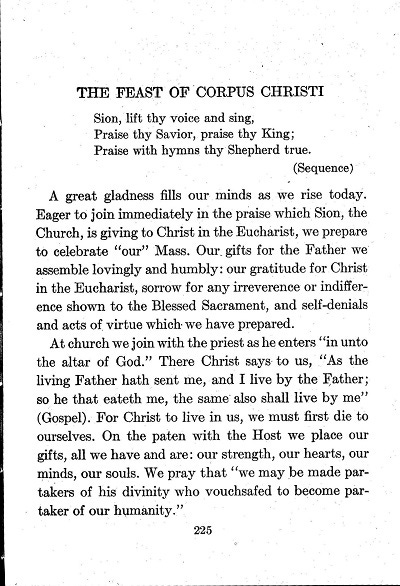Originally published, June 2024 at Charlotte Was Both
Are Corpus Christi processions and Eucharistic devotions that adoration-centered simply displays that are disconnected from the actual demands of discipleship?
I suppose they can be, because anything at all can be corrupted. Even a simple Mass with a lay homilist, the latest GIA musical stylings and an ad-libbed Eucharistic Prayer. Hard to believe, I know.
As images and videos of processions filled social media feeds, that evolved into one of last weeks’ Catholic Twitter discussions, but of course it’s not a new concern, and it’s not even unique to our post Vatican II – era. Of course spiritual teachers and writers have always been aware of the potential for insularity and triumphalism on the part of individuals or communities who profess faith. That is, the human tendency to completely forget what we’re doing all this for in the first place.
When some observers of, say, the many Corpus Christi processions that occurred over the past few days, say that this must be about nothing more than engaging in public piety for the sake of showing off or flexing, they are not only revealing something about their own spirituality, but, I’m going to suggest, offering unintentional insight into the state of contemporary popular Catholic spirituality and this (I think) transitional period that we’re in.
Traditionally – that is, deeply traditionally – Catholics understood that the goal of the faith-filled life was, of course, eternal life with God, a life for which all people are created and are waylaid from because of sin. Eternal life is attained through God’s grace and our cooperation with it. Cooperating with God’s grace – offered through the life of the Church, the Body of Christ – means, at root, conforming oneself to Christ. Which means living a life of agape, self-sacrificing love focused on God first, then others. All of this was embodied, in the Christian way of prayer, participation in the life of the Church and letting that grace – that is the life of God – flow through your daily actions, systematized, really, in the Works of Mercy.
So the purpose of a public display of piety or even adoration-centered devotions certainly might take on aspects of display for its own sake or community pride, but in essence, it was understood and assumed that the spiritual end of this for every person there was a deeper faith, a deeper connection to Christ – which meant, everyone knew, an ever deeper grounding in love of God and neighbor.
(“Everyone knew” does not equal “Everyone did this” or that less spiritually mature motivations (do this and say this so I won’t burn) weren’t at play. Again: life/humans/continual need for reform of course.)
In 21st century American Catholicism, the spiritual assumptions and goals are different now. As I have written before – so many times– American Christianity in general is focused on what American culture is focused on: self-fulfillment and “happiness” in this life. Feeling affirmed, good about oneself, accepted by the universe, strengthened and energized to follow one’s dreams and fulfill one’s potential.
Here’s the irony, then. In that landscape, in which we are all essentially spiritually okay, and the main purpose of faith is to tell us we are okay, no repentance or metanoia required, then, yes, a Eucharistic procession is perhaps more likely to strike the onlooker, even the Catholic, as an exercise in identity-flexing, disconnected from the demands of discipleship.
When the purpose of faith is to reassure you that you okay just as you are, when the effect of God’s presence among us is understood and evaluated primarily in terms of the emotions and sensations it evokes, yes it becomes challenging to understand the purpose of any public devotion – or perhaps spiritual practice at all – in a way that is anything else but performative acts of self-affirmation, rather than, first of all, an act of praise, and secondly, one more encounter with the grace that, when we are open, changes us and brings us into deeper conformity with Christ, which means – you guessed it – a greater capacity to love.
Then with love immeasurable, Christ fulfills his promise and gives Himself to us that we may live by him. With Christ abiding in us, we go out to the work of the day. Christ in our memories, in our hearts, in our minds, on our lips, in our actions; Christ in us and we in Him!
And what does that mean – to live by him?
What does it mean to go out with Christ abiding in us?
Not, it was understood, to simply feel good about ourselves, confident that we are accepted by the universe because Christ “abides” in us. No, to live by him to live knowing that Christ abides in us was understood to mean – follow me.






